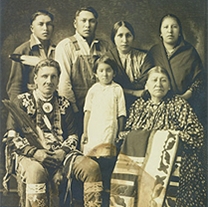 |
Recipient: Grant: Pictured: |
Web site: Contact: |
||
A wolf-skin shirt, a buffalo-horn spoon, and a tipi covering are among the 685 Omaha Indian artifacts located, photographed, and published on the Omaha Virtual Museum Web site (http://omahatribe.unl.edu). The University of Nebraska-Lincoln (UNL) project was supported by the U.S. Institute of Museum and Library Services (IMLS) under a National Leadership Grant.
"We did this for the children," said Dennis Hastings, MA, founder and director of the Omaha Tribal Historical Research Project, Inc., member of the Omaha tribe, and one of the project originators. "We’re experimenting with this new media to try to maintain our culture. It helps us to communicate with tribal people and to educate people throughout the world," Hastings said. The Omaha are the only Native American tribe left in Nebraska who lived there before Europeans arrived in North America.
In addition to the artifacts, the museum includes 339 pages of important texts on Omaha Indian culture and 50 photographs that are held in museums in Germany, France, England, Switzerland, and the U.S. The Web site also includes 363 artifacts and related text from other tribes for comparative studies.
For Thomas P. Myers, Ph.D., a UNL professor of anthropology and project director, the impetus for the project grew out of his frustration with the wide dispersal of artifacts necessary to his research. During the first phase of the grant, he identified the location of the artifacts and selected the most representative examples.
UNL Libraries, which has significant experience in cataloging images and creating web accessible databases, and the UN State Museum, which houses some important Omaha artifacts, took on the project after Myers retired following the grant’s first phase. The Nebraska State Historical Society was a key project partner. Its assets include Omaha artifacts in the Museum of Nebraska History, Omaha photographic images in the Library and Archives, and a state-of-the art digitization lab.
"We were careful to include only Omaha artifacts. This was difficult because there was so much influence from other tribes," said Dee Ann Allison, MLS, UNL Computing Operations and Research Services and the project’s co-principal investigator.
Allison, who worked on the Web site for four years, created and embedded into the texts graphic images that help people to pronounce words in the Omaha language. She also standardized the photographs to make it easier to adjust to future technological changes.
Visits to the Web site have increased by 50 percent every year since its September 2005 launch. The virtual museum is being used most by students at the Nebraska Indian Community College, Hastings said. All parts of the site are being visited, with the most popular parts varying between the database, the digital texts, and the photos.
Based on the results of a user survey, Allison and Hastings are working to enhance the Web site, add content, and provide more information from the Indian perspective.
"The whole effort is ongoing. We’re keeping up with information and communicating," Hastings said. "Someone at a powwow in New Mexico said they’d heard about our website. We felt very proud of it because we’re doing something for our culture. If other tribes want to do something like this, so much the better."